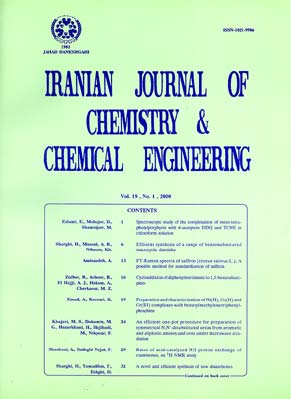فهرست مطالب

Iranian Journal of Chemistry and Chemical Engineering
Volume:17 Issue: 1, May-Jun 1998
- تاریخ انتشار: 1377/06/20
- تعداد عناوین: 9
-
Page 1Tow new compound of type [(chelate) 2Cu-OH-Cu (chelate) 2]X3. nH2O, where chelate=1, 10-phenanthroline; X=Cl- (n=3. 5) and chelate=4, 4إ-dimethyl-2, 2إ-bipyridine; X=ClO-4 (n=5) have been synthesised and theirproperties investigated. The complexes show room temperature magnetic momentorder of 1. 0 B. M. per copper atom. The X-band ESR spectrum of powderedsamples at room temperature shows typical Dm=1 transition at gav=2. 075 for1, 10-phenanthroline and gav=2. 085 for 4, 4إ-dimethyl-2, 2إ-bipyridine, and muchweaker Dm=2 transition at half-field which is the characteristic of dimeric unit.
-
Page 4A competitive spectrophotometric method has been used for thestudy of complexation between Cu2+, Zn2+ and Cd2+ (M) and 18-crown-6 (18C6, B) in methanol using 4- (2-thiazolylazo) resorcinol (TAR, HL) as thecolorimetric complexant. Absorption spectra of the species in the M-TAR-18 C6system at various concentrations of 18C6 showed no formation of ternarycomplex, MLB, and the stoichiometry of the resulting complexes was found to be1:1 under the condition used. The formation constants of both types of complexes (ML and MB) were determined using the conditional formation constant of MLcomplexes at constant acidity in the absence (KMLإ) and presence (KMإLإ) of18C6. The results showed that the KMB values increased in the order ofCu2+
-
Page 8Slurries of rice-straw cellulose (obtained by delignification andremoval of hemicellulose from the powdered raw material) were subjected toultrasonic waves at different intensities for various times (constant temperature). Susceptibility of the samples to cellulase-hydrolysis increased initially withpretreatment time, reaching a maximum or a constant level thereafter. Maximumglucose yield (~21%) was obtained under the following conditions: enzyme/substrate ratio؟ 0. 1; amplitude 18 mm (peak to peak), and exposure time 30minutes. This yield is 30X that of the starting raw material, 10X that of theuntreated rice-straw cellulose and 12-13X that of the value reported by othersregarding pretreatment of wheat-straw cellulose by phenol. Changing theenzyme/substrate ratio to 0. 4 raises glucose yield to 42%, under the sameconditions. Removal of temperature control during pretreatment (50-80ـC) increases the yield up to ~30% without increasing the enzyme/substrate ratio.
-
Page 14Starting from readily available 2-substituted-4-methylthiazole-5-carboxylic acid hydrazide (1), The title compounds were prepared. The reaction ofcompound 1 (R=CH3) with formic acid yielded 1-(formyl)-2-(2,4-dimethylthia-zole-5-carboxyl) hydrazine (2). Refluxing the latter with phosphorous pentasulfidein xylene afforded compound 3, the reaction of compound 2 with phosphorous pen-toxide afforded compound 4. Reaction of compound 1 with substituted isothio-cyanates followed by cyclization of the intermediate 5 in basic medium gave 4-alkyl-5-(2- substituted-4-methyl-5-thiazolyl)-2,4-dihydro-3H-1,2,4-triazole-3-thione(6). Alkylation of compound 6 followed by subsequent oxidation of intermediate7 gave compound 8. The reaction of acid chloride 11 with hydrazide 12 affordedcompound 13 which was cyclized by P2S5 or P2O5 to compounds 14 or 15 respec-tively. Compounds 3 and 14 showed significant activities against E. Coli andBacillus Subtilis.
-
Page 21The electrochemical behaviour of nifedipine (I), nitrendipine(II) andtheir photodegradation products has been studied by employing electrochemicaltechniques in chloroform and in 1:4 mixture of chloroform-isopropanol using piper-idinium perchlorate (PPC) as supporting electrolyte. It has been shown that I and IIundergo in a 4e, 4H+ irreversible reduction reaction, while the reduction product,phenylhydroxylamine, is oxidized in a 2e, 2H+ reversible process to an unstablenitrosophenyl compound. Photodegradation of I and II by sunlight produces a nitro-sophenyl derivative which is reversibly reduced to the corresponding unstable phenyl-hydroxylamine. No significant change is observed in electrochemical properties of drugsby passing from chloroform to chloroform-isopropanol mixture. The possibility ofanalysis of I and II by dp polarography is also verified.
-
Page 29The first highly accelerated Niementowski reaction of anthranilicacid with some amides or ketones under microwave irradiation leading toquinazolinones and quinoline derivatives is described. These reactions representsome examples of efficient microwave irradiation promoted organic condensationin which the reactions can be carried out in open vessels and provides products ofhigh purity with simple work up.
-
Page 38Protonation of the reactive intermediates generated in the reaction between dialkyl acetylenedicarboxylates and triphenylphosphine by isonitrosoacetophenine leads to vinyltriphenylphosphonium salts, which undergo intramolecular Wittig reaction to produce dialkyl 4-phenyl-N-hydroxypyrrole-2,3-dicarboxylates in moderate yields.
-
Page 42Classical trajectory (Monte Carlo) calculation is used to calculatecollision rate constants of ion-quadrupolar molecule interactions for theH-+C2H2 system. The method presented here takes into account the effect of theinduced dipole-induced dipole potential on ion-quadrupolar molecule collisionrate constants. It is also assumed that the colliding particles have a definite size.The thermal energy collision rate constants are calculated at 300-3000 K tempera-ture range and the kinetic energy dependence of rate constants is examined at arelative kinetic energy of the colliding particles in the range from thermal energyup to ~1.3 eV. It is suggested that the induced dipole-induced dipole potentialterm and the particles size are important factors and should not be ignored whencalculating collision rate constants of ion-quadrupolar molecule system.


